Regardless of whether your dog is a complete beginner with the stay cue OR they’re struggling with a more advanced version, I want to teach you how to train stay so that it works in ALL scenarios.
If you prefer following video tutorials, I taught Brooks how to “Stay” for my Youtube channel:
In this blog post I’m going to cover:
- The 3 D’s of training stay
- How to properly progress the difficulty so that your dog gets amazing at this cue without any corrections
- How to prevent some of the most common mistakes that I see made when training stay
- What to do when your dog DOESN’T stay after you’ve asked them to so that they get it right the next time.
To train your dog to stay, you’re going to need 3 things:
- A low distraction room
- A loaded marker word. Marker words dramatically speed up training because they allow for more precise rewarding, so if you don’t know what a marker word is read THIS
- Training treats that your dog really loves
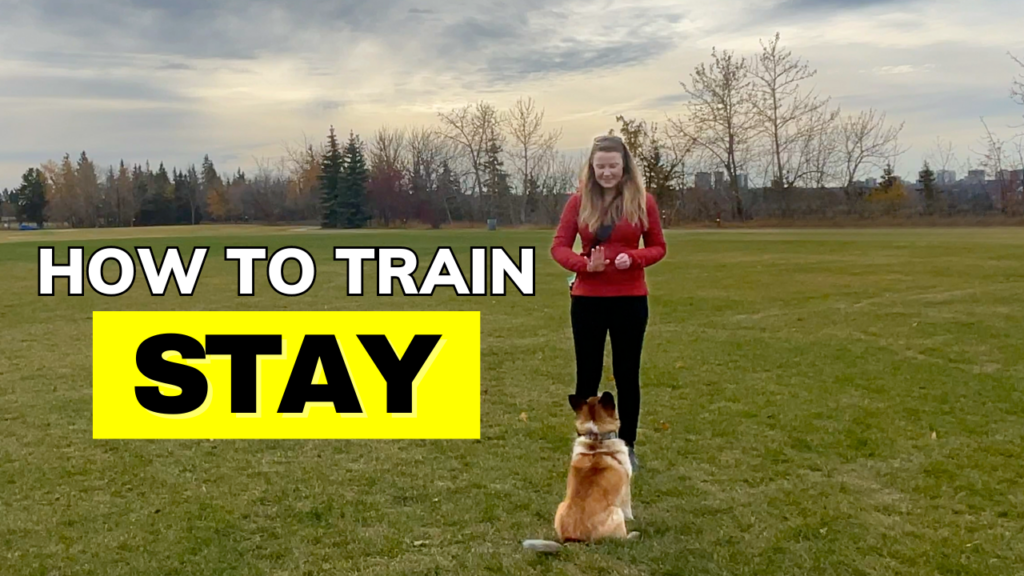
There are three D’s when training stay: Duration, Distance, and Distraction.
Duration is the amount of time that your dog is in a stay for, distance is how far from your dog you go, and distraction is anything that happens during your dog’s stay.
I ALWAYS start with duration when I first start training stay. I’ll explain why in a minute.
How to Train Stay: Step 1- Distance
Start with your dog in whichever position you want them to stay in, then say “stay” while also giving a hand signal.
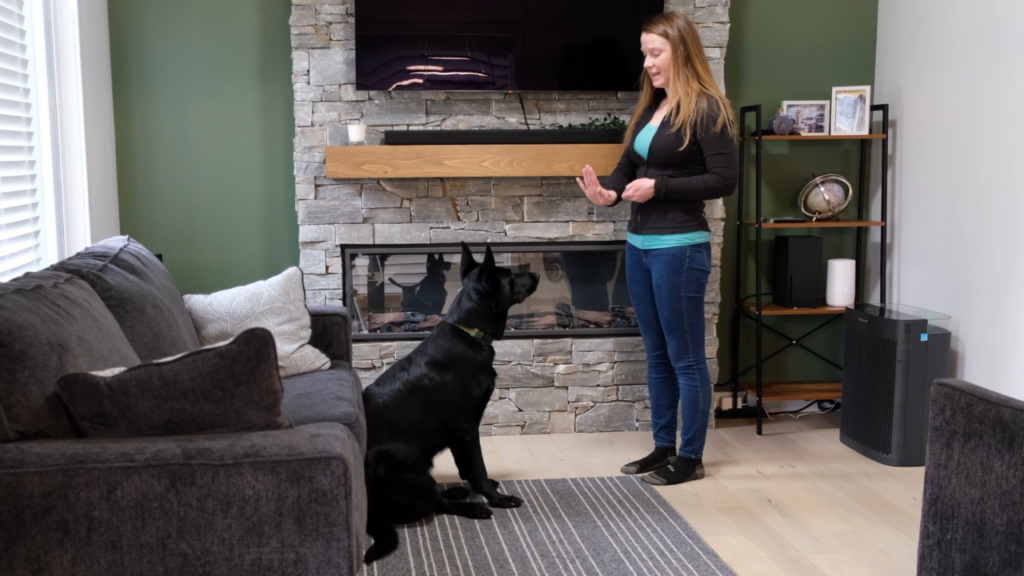
Initially say “yes” (or whatever marker word you use) & reward your dog for holding that position for even a second or two. Make sure your dog DOESN’T pop out of position to get their reward!
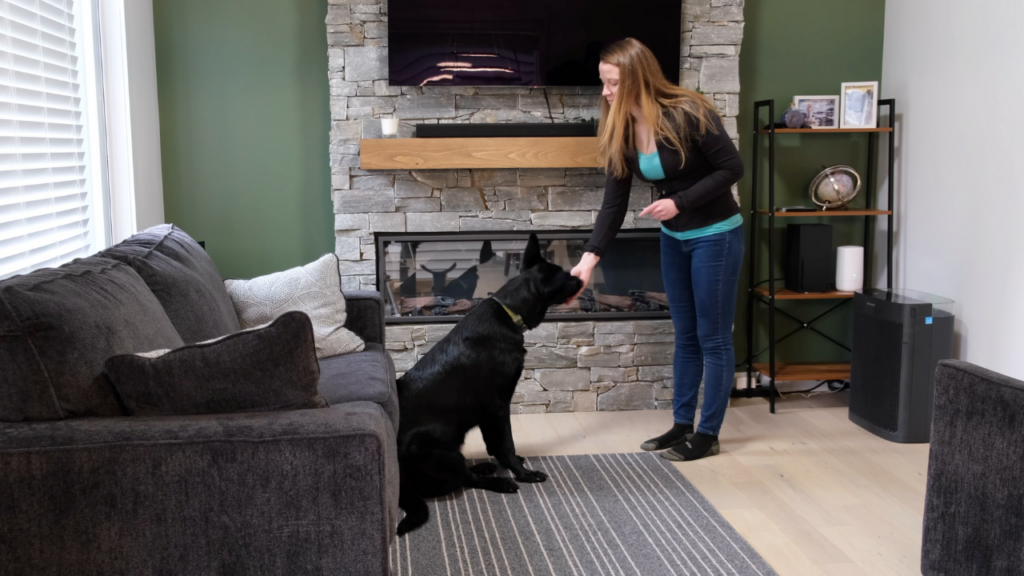
You may feel silly rewarding them so soon, but in order to build a strong skill set there needs to be a solid reward history. By starting with incredibly short durations, you’re almost guaranteeing that they’re going to get it right. This gives your dog lots of opportunities to get rewarded and really understand that the cue “stay” means “don’t move”. This builds a strong foundation for when we start increasing difficulty, so don’t rush this!
It’s also important for stay to have an on & off switch. Once you say “stay” the expectation is that the stay is still ongoing until released. To condition a release cue: toss a treat and say “ok” (or whichever term you choose) so the dog knows to move out of the position it was holding. This is a good habit to build for when you get to REALLY stimulating situations or much longer durations. You’ll want to be able to reward your dog for doing a good job WITHOUT the stay actually being finished. Depending on difficulty and how the dog is doing, re-cue the stay 3-5 times before giving the “ok” cue for a break.
I strongly encourage you to progress slowly here, and to only add ~ 1 second at a time. When working on duration, I like to progress slowly enough that there are minimal mistakes or times your dog breaks that stay.
By aiming for almost error-less learning you’re building a really strong foundation for the skill!
One mistake that YOU should avoid is accidentally having bizarre posture when teaching stay. Dogs do pick up on context and body language, so try to have normal posture & movement as you train.
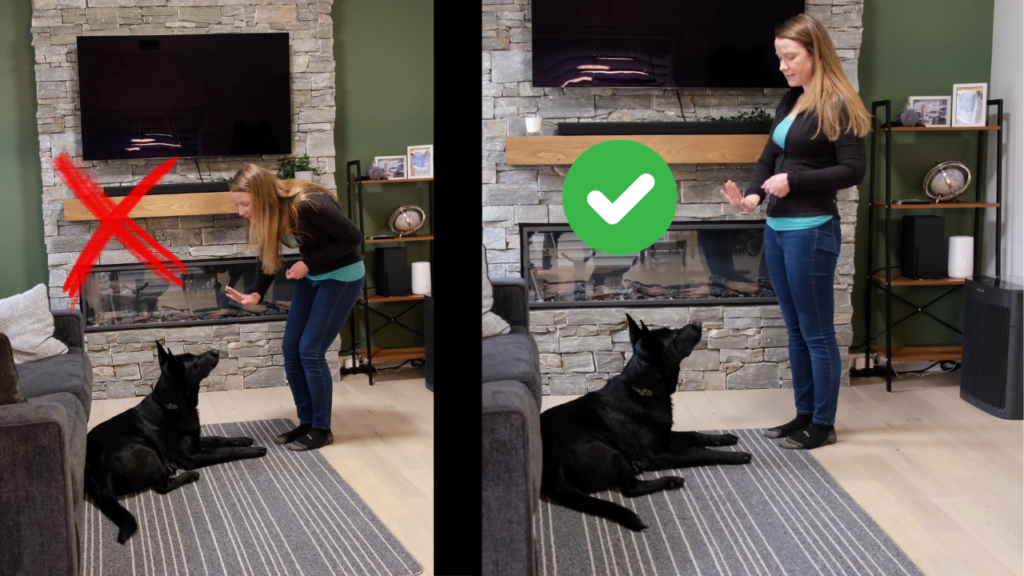
While building duration, don’t step away or add distance because that makes the cue much harder. Aim for approximately a 10 second stay in both a down and sit position before adding ANY distance. Why? It’ll take about that much time to walk away and return to your dog when adding any distance. Therefore proofing for that helps break training into more manageable increments for your dog.
And lastly, why do I suggest practicing in both a sit and down position? We want the dog to generalize that “stay” means “hold whatever position you’re in”.
Once the dog is proofed for a 10 second stay duration, then add distance!
How to Train Stay: Step 2- Distance
When you start adding distance, make sure that you again do this progressively!
Start by taking just one or two steps away from your dog, and then go back and reward. Repeat this a bunch of times, then gradually move farther & farther away.
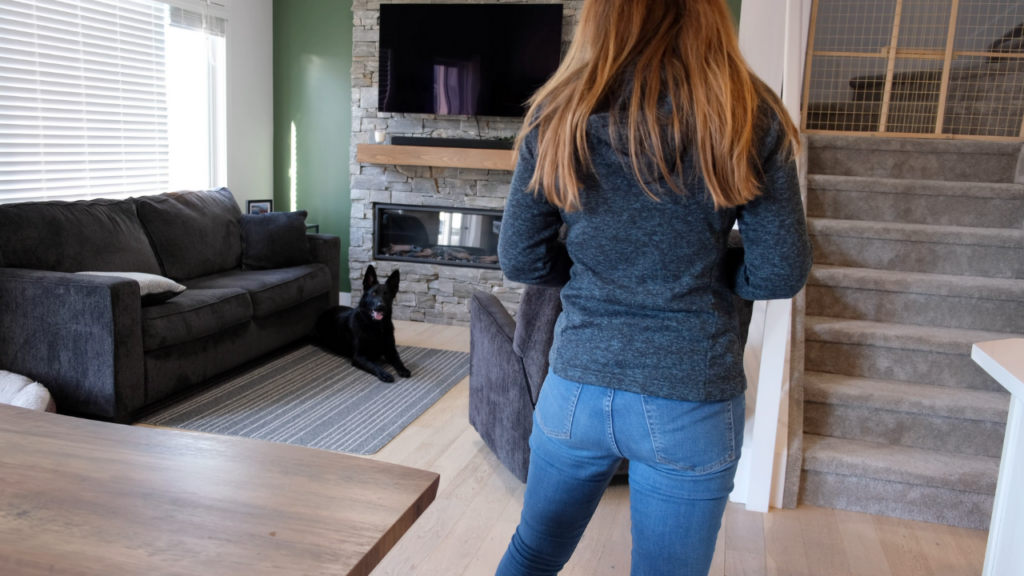
How to Train Stay: Step 3- Distraction
There are many kinds of distractions that I like to proof the dog for during stay training including food distractions, surprise movements, toys, and new environments. Your dog likely WILL make mistakes with distractions, so I’ll also explain how to handle it when your dog does not stay.
Let’s start with adding unpredictable movements as a distracting addition to stay training:
The world is going to do some weird, unpredictable things, so make sure you also rehearse some during training!
Same as the other steps, try to gradually increase distraction levels while being as unpredictable as possible to keep your dog guessing.
It’s still important to practice different distractions in both a sit and a down to help your dog generalize the skill!
Some suggestions for random things you can try are jumping jacks, star spins, clapping, or hiding out of sight during training.
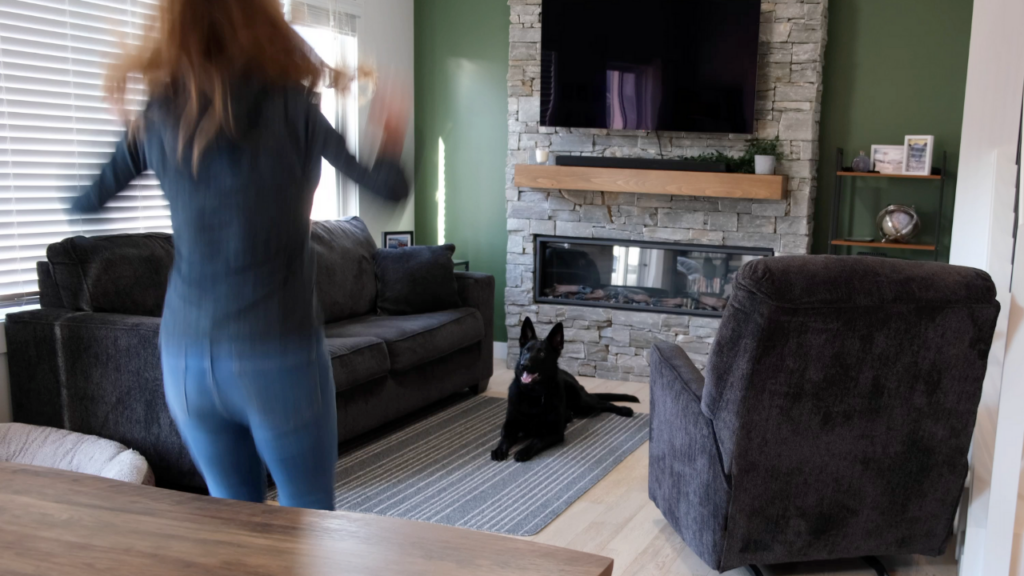
I often say: if you feel a little bit crazy while training stay, you’re probably doing it correctly.
What if your dog DOESN’T stay after you’ve asked them to?
If your dog breaks their stay, simply put them back in position without rewarding, and then progress more slowly back to the level they struggled with. When your dog breaks their stay it’s simply a sign that you increased difficulty too quickly! When you progress more gradually, you’ll see they’re capable of holding a stay regardless of distraction.
Now let’s talk about adding food distractions into training:
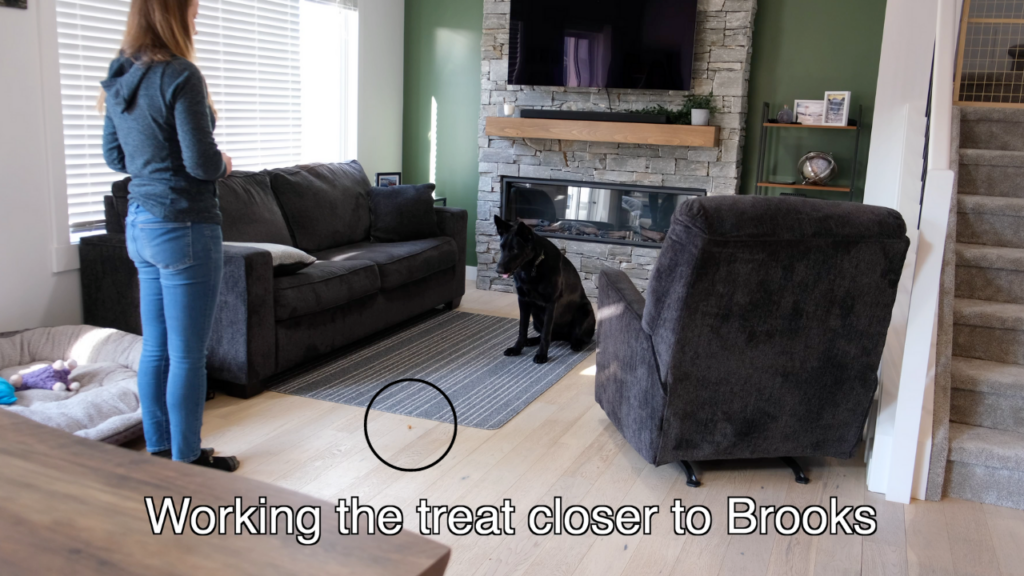
I’ll often place or throw treats onto the ground (out of the dogs grasp) during stay training as added distraction practice.
If you do use treats as a distraction during training, make sure that you block ANY attempts to break the stay and steal the treat. If your dog DOES eat the distraction treat, they’ve actually been rewarded for breaking the stay, so proceed very cautiously here!
There are a few ways to make treats more or less difficult as distractions:
- Treats that you throw are much more distracting than ones placed quietly on the ground. Remember: more movement makes things more difficult.
- Duration: the entire time the treat is sitting there it’s a compound distraction!
- The value of the floor treat. If it’s a food your dog loves, it’s going to be harder for them to resist.
During training it’s a good idea to make the reward you’re offering (for staying) better than whatever you put on the floor. We want our dog to know that waiting gets the best thing!
And lastly, let’s talk about proofing “stay” in new environments:
I strongly encourage to start training “stay” indoors where there’s minimal distractions except the ones you intentionally add. Only once your dogs “stay” skills are REALLY solid do I take training outdoors.
If you have a yard, practice there next. (If you don’t, any quiet field will work).
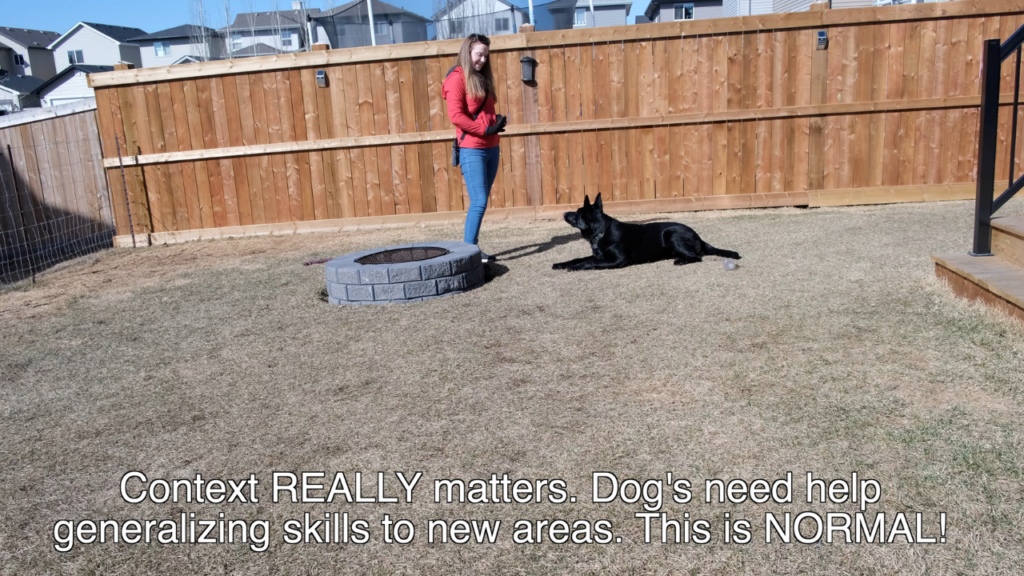
Dogs don’t generalize skills well without practice. When you first go outside you may find that your dog struggles with a basic stay even without distractions. Try not to stress about this because it’s normal!
When you take stay training outdoors, take a massive step backwards in difficulty. We still want training to be as error-less as possible! How? Start with just a few second stay right next to your dog, then progress back to 10 seconds. Once that’s easy, slowly increase distance & distractions like you did indoors. With repetitions you’ll be amazed at how solid your dogs stay becomes!
One big mistake to avoid when training your dog to stay:
Once you start training at much farther distances, it can be tempting to call your dog to you. However, this is a big mistake!
Think about this from the reinforcement perspective: Dogs repeat what works!
If your dog waits when you say stay, but then you call them to you, what did the dog ACTUALLY get the reward for? Running over to you! Staying in position got them nothing, while running after you got them a treat. Which behaviour have you accidentally reinforced?
Oops.
If instead YOU return to your dog the reward occurs for holding their position, which is exactly what stay means! This small change will have a dramatic effect on how solidly your dog learns the stay cue.
Still have training questions? This tutorial on Youtube demo’s everything in this blog post & more:
Happy training 🙂
Disclosure: Happy Hounds uses affiliate links. Purchasing with these links will not cost you any extra, but I get commissions for purchases made through these links. Affiliate links help me to continue to offer free resources & blog posts. I would love if you used them!
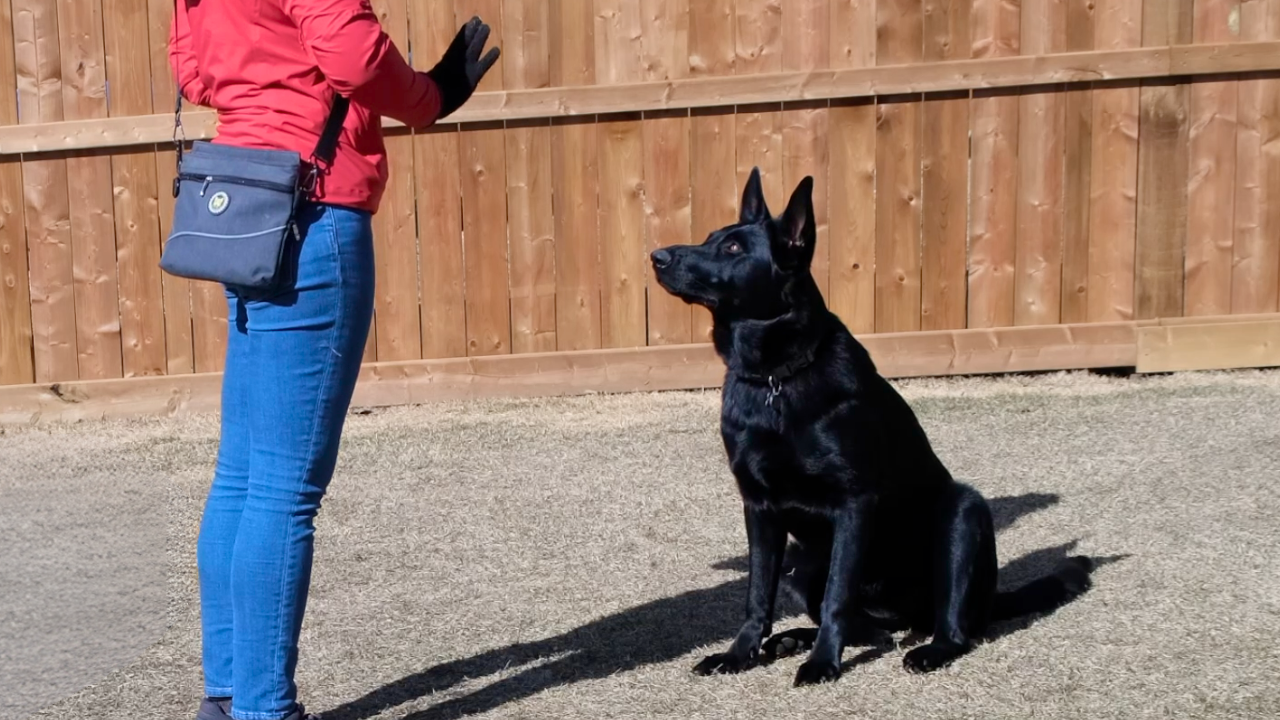

+ show Comments
- Hide Comments
add a comment